Somalia |
|
|
|
| Übersicht – Contents: | |
Somalia |
|
|
|
| Übersicht – Contents: | |
Flagge – Flag: |
|
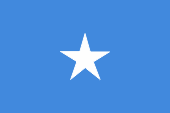 |
Nationalflagge – national flag, |
historische Flaggen – historical Flags: |
|
| Italienisch-Somaliland – Italian Somaliland: | |
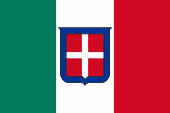 |
1851–1941, Italien – Italy, National- und Handelsflagge – national and merchant flag, Seitenverhältnis – ratio = 2:3, Quelle/Source, nach bei: Das Flaggenbuch  |
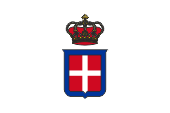 |
1908–1936, Flagge des Gouverneurs – flag of the Governor, Seitenverhältnis – ratio = 2:3, Quelle/Source, nach bei: Das Flaggenbuch |
 |
1941–1950, britisch besetzt – occupied by U.K., Flagge Großbritanniens – flag of United Kingdom, Seitenverhältnis – ratio = 1:2, Quelle/Source, nach/by: Die Welt der Flaggen |
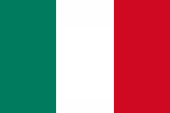 |
1950–1960, |
 |
1954–1960, |
| Britisch-Somaliland – British Somaliland: | |
 |
1884–1960, Union Flag → quasi Nationalflagge, |
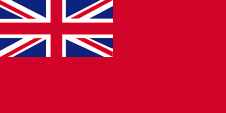 |
1884–1960, |
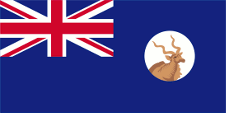 |
1903–1950, Flagge der Regierung (Staatsflagge) – flag of the government (state flag), Seitenverhältnis – ratio = 1:2, Quelle/Source, nach/by: Flags of the World   |
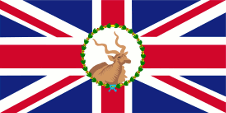 |
1903–1950, Flagge des Gouverneurs – flag of the Governor, Seitenverhältnis – ratio = 1:2, Quelle/Source, nach/by: Flags of the World   |
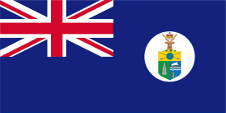 |
1950–1960, Flagge der Regierung (Staatsflagge) – flag of the government (state flag), Seitenverhältnis – ratio = 1:2, Quelle/Source, nach/by: Flags of the World   |
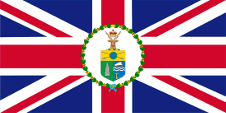 |
1950–1960, Flagge des Gouverneurs – flag of the Governor, Seitenverhältnis – ratio = 1:2, Quelle/Source, nach/by: Flags of the World   |
| Die heutige Flagge von Somalia wurde am 12.10.1954 für Italienisch-Somaliland eingeführt und zur Unabhängigkeit am 01.07.1960 durch das vereinigte Somalia übernommen. | The today’s flag of Somalia was introduced for Italian Somaliland on 12th of October in 1954 and was tooken over at the independence of the united Somalia on 1st of July in 1960. |
| Die Flagge zeigt ein einfarbiges hellblaues Grundtuch mit einen weißen fünfzackigen Stern in der Mitte. Aussehen und Farbe der Flagge des Landes wurden zuletzt festgelegt in Artikel 6 der Verfassung der Bundesrepublik Somalia von 2012, natürlich auch in den vorhergehenden Verfassungen. Die Farbe der Flagge wird dabei erneut lediglich als "Hellblau" definiert und die Größe der Sterns wird wiederholt überhaupt nicht erwähnt. | The flag
shows a single-coloured pale blue bunting with a white five-pointed star in
the middle. The appearance and colour of the country's flag were last defined in Article 6 of the 2012 Constitution of the Federal Republic of Somalia, and of course in previous constitutions. The colour of the flag is again only defined as "light blue" and the size of the star is repeatedly again not mentioned at all. |
| Zur Bedeutung der Farben und der Symbolik gibt es zwei Theorien: | To explain the meaning of the colours and of the symbolism there are two theories: |
|
|
| Als Awale Liban die Flagge 1954 schuf, bezog er sich angeblich auf das Blau der Flagge der Vereinten Nationen (UNO). Damit müsste das Hellblau offiziell dem UNO-Blau entsprechen, womit Pantone 279 zu verwenden wäre. Betrachtet man sich aber die obere Hälfte des 1919 geschaffenen Wappens von Italienisch-Somaliland ist das Design und die Farbe der Flagge schon recht gut erkennbar. | When Awale Liban created the flag in 1954, he supposedly referred to the blue of the United Nations (UN) flag. This means that the light blue should officially correspond to the UN blue, which means that Pantone 279 should be used. However, if you look at the upper half of the coat of arms of Italian Somaliland created in 1919, the design and colour of the flag is already quite recognisable. |
| Vom Territorium des ehemaligen Somalia spalteten zwischen 1991 und 2006 mindestens drei Staten ab und Somalia selbst hörte sogar zeitweise auf zu bestehen. Die beiden Somalia-Staaten Puntland und Galmudug (bis 2017) verwenden ebenfalls die somalische Flagge. | From the territory of the former Somalia separated between 1991 and 2006 at least three states and Somalia itself even momentaryly finished its existence. The both Somalia-States of Puntland and Galmudug (to 2017) use as well the Somali flag. |
| Britisch-Somaliland entstand 1887, nachdem die Briten im Ägyptischen Somaliland im Februar 1884 die Macht übernommen hatten, Ägypten war 1882 von Großbritannien erobert worden, unterstand aber zunächst von Aden aus der Verwaltung von Britisch-Indien. Im Jahre 1903 erhielt Britisch-Somaliland eine eigene Verwaltung und somit einen eigenen Gouverneur. Damit hatte die britische Verwaltung der Kolonie das Recht einen eigenen sogenannten "Blue Ensign" zu verwenden, ein dunkelblaues Flaggentuch mit einer Flaggendarstellung – dem britischen Union Jack – in der Oberecke mit einem Abzeichen im wehenden Ende. Für alle anderen Zwecke war bis dato an Land ausschließlich der britische Union Jack zu verwenden und zur See die übliche rote britische Handelsflagge, der "Red Ensign". |
British Somaliland came
into being in 1887 after the British had taken power in Egyptian Somaliland
in February 1884. Egypt had been conquered by United Kingdom in 1882, but was
initially under the administration of British India from Aden. In 1903, British Somaliland received its own administration and thus its own governor. This gave the British administration of the colony the right to use its own so-called "Blue Ensign", a dark blue flag bunting with a representation of a flag - the British Union Jack - in the upper corner, with a badge in the waving end. For all other purposes, only the British Union Jack was to be used on land and the usual red British merchant flag, the "Red Ensign", was to be used at sea. |
Großbritannien hatte
in Jahr 1864 ein Flaggensystem eingeführt, in dem:
Seit 1865 durften Schiffe von Kolonialregierungen einen Blue Ensign mit einem Badge (Abzeichen) im fliegenden Ende führen. Die jeweiligen Regierungen sollten entsprechene Bagdes zur Verfügung stellen. Handelsschiffe und seefahrende Privatpersonen aus Kolonien dürfen nur dann einen Red Ensign mit Badge führen, wenn von der britischen Admiralität eine entsprechende Erlaubnis für die Kolonie erteilt wurde. Für Britisch-Somaliland war eine solche Genehmigung nie erteilt worden, und so wurde zur See offiziell nur die übliche rote britische Handelsflagge, der "Red Ensign" ohne ein Abzeichen im wehenden Ende verwendet. |
United Kingdom
introduced a flag system in 1864 in which:
Since 1865 ships of colonial governments were permitted to fly the Blue Ensign with a badge in the flying end of the flag. The respective governments were asked to design appropriate badges. Merchant ships and seafaring persons from colonies were only permitted to use the Red Ensign with a badge, then also named Civil Ensign, if permission has been given to the respective colony by the British admiralty. Such a permission had ever been granted for British Somaliland, and so only the usual red British merchant flag, the "Red Ensign" without a badge in the waving end, was officially used at sea. |
| Ein solches Badge war oft eine auf einer Scheibe platzierte regionale landschaftliche Darstellung, zeigte oft Schiffe, historische Begebenheiten oder konnte auch nur eine Art Logo sein. Sehr oft zeigte ein Badge zusätzlich den Namen des Landes oder auch einen Wahlspruch. Einige Besitzungen hatten aber auch schon von Anfang an ein Wappen, bzw. erhielten über die Jahre eine eigenes Wappen und das Badge wurde abgeschafft. Um ein weitgehend einheitliches Erscheinungsbild im fliegenden Ende der Flaggen zu gewährleisten, wurden Wappen und auch andere Symbole auf einer weißen Scheibe in der Größe der früheren Badges dargestellt. Es gab hier aber auch Ausnahmen, denn einige Kolonien verwendeten diese weiße Scheibe nicht, und platzierten ihr Wappen oder auch nur das Wappenschild - manchmal auch vergrößert - direkt auf das Flaggentuch. Schon in den 40-er Jahre wurde dazu übergegangen die weiße Scheibe zu entfernen und das Wappen direkt zu platzieren oder vergrößert dazustellen. Dieser Umstellungsprozess erfolgte allmählich, nirgendwo gleichzeitig und vollständig. In einigen britischen Besitzungen sind bis heute Flaggen mit der weißen Scheibe in Gebrauch, in anderen nicht mehr und in einigen Gebieten gibt es beide Varianten nebeneinander. | Such a badge was often a regional landscape representation placed on a disk, often showing ships, historical events or even a kind of a logo. Very often, a badge also showed the name of the country or a motto.
Some British possessions, however, already had a coat of arms from the beginning, or their badge was replaced by a coat of arms over the years. To ensure a uniform appearance in the flying end of the flags, coats of arms and other symbols were displayed on a white disk in the size of the earlier badges. There were also exceptions, because some colonies did not use the white disk and placed their escutcheon or even coat of arms directly on the bunting, sometimes enlarged. Already in the '40s they started to remove the white disk and placed the coat of arms directly or enlarged. This conversion process was done gradually, nowhere at the same time and completely. In some British possessions, flags with the white disc are still in use, in others no more and in some areas are both variants in use, next to each other. |
| Quelle/Source: Die Welt der Flaggen, Flaggen und Wappen der Welt, Wikipedia (EN), Flags of the World, Flaggen Wappen Hymnen, Volker Preuß | |
| Wappen – Coat of arms: | |
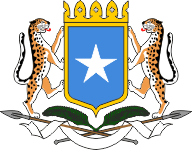 |
seit/since 1956, Das Wappen von Somalia – coat of arms of Somalia, Quelle/Source, nach/by: Wikipedia (DE), Corel Draw 4 |
 |
1919–1936, Das Wappen von Italienisch-Somaliland – coat of arms of Italian Somaliland, Quelle/Source: Wikipedia (DE), Angelus, CC BY-SA 3.0, via Wikimedia Commons |
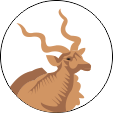 |
1903–1950, Emblem (Badge) von Britisch-Somaliland – Badge of British Somaliland, Quelle/Source, nach by: Flags of the World |
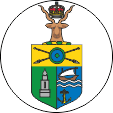 |
1950–1960, Emblem (Badge) von Britisch-Somaliland – Badge of British Somaliland, Quelle/Source, nach by: Flags of the World |
| Das
heutige Staatswappen Somalias wurde am 10.10.1956 für Italienisch-Somaliland
eingeführt und zur Unabhängigkeit am 01.07.1960 durch das vereinigte Somalia
übernommern. Es zeigt auf einem golden umrandeten Schild das Motiv der
Nationalflagge, darüber eine goldene Krone als Symbol für Souveränität.
Schildhalter sind zwei Leoparden. Unterhalb des Schildes zwei gekreuzte Speere und zwei gekreuzte Palmwedel. Die Speere werden von einem goldenen Band zusammen gehalten. Auf einigen Darstellungen erscheint das Band jedoch in Gold. Die Gestaltung geht in Teilen auf das 1919 eigenführte Wappen von Italienisch-Somaliland zurück, denn der fünfzackige weiße Stern auf blauem Grund lässt sich schon dort finden, ebenso ein Leopard. Das Wappen von Italienisch-Somaliland war bis 1936 verwendet worden, dann gehörte das Land bis 1941 zu Italienisch-Ostafrika. Nach dem Zweiten Weltkrieg musste Italien seinen Kolonialbesitz weitestgehend sofort an die Sieger des Zweiten Weltkriegs abgeben. Lediglich Italienisch-Somaliland wurde 1950 von den Briten geräumt und wieder den Italienern überlassen, unter Aufsicht der UNO, bis das Land 1960 unabhängig wurde. Schon 1956 wurde das heutige Wappen eingeführt. Britisch-Somaliland hatte ab 1903 eine eigene Verwaltung, so dass hier ab 1903 ein eigenes Abzeichen (Badge) verwendet wurde. Es war eine weiße Scheibe mit einer Kudu-Antilope darauf. 1950 war ein reguläres Wappen eingeführt worden, das nun anstelle der Antilope im Badge erschien. |
The
today’s coat of arms of Somalia was introduced for Italian Somaliland on
10th of October in 1956 and was tooken over at the independence of the
united Somalia on 1st of July in 1960.
It shows on a golden bordered shield the motive of the national flag, above
that a golden crown as symbol for sovereignty. Shield supporters are two
leopards. Below the shield two crossed spears and two crossed palm tree
twigs. The spears hold together by a golden banner. In some reproductions
however the banner appears in gold. The design goes in part back to the coat of arms of Italian Somaliland, which was been adopted in 1919, because the five-pointed white star on blue background can already be found there, as well as a leopard. The coat of arms of Italian Somaliland was used to 1936, when the country became part of Italian East Africa until 1941. After the Second World War, Italy had to hand over most of its colonial possessions immediately to the victors of the Second World War. Only Italian Somaliland was vacated by the British in 1950 and returned to the Italians, under UN supervision, until the country became independent in 1960. The present coat of arms was introduced as early as 1956. British Somaliland had its own administration from 1903, so its own badge was used here from 1903. It was a white disc with a Kudu Antelope on it. In 1950, a regular coat of arms had been introduced, which now appeared in the badge instead of the antelope. |
| Es zeigte auf einer weißen Scheibe einen Schild, in dessen Schildhaupt zwei gekreuzte Somali-Speere und ein Somali-Schild zu sehen waren. Das gespaltene Schild zeigte rechts eine arabische Dhau (Segelschiff mit einem Segel) stilisierte Wellen und einen Anker, ein Hinweis auf die Gründung des Landes durch Händler und Seefahrer. In der linken Hälfte des Schildes das "Silberne Minarett", den Turm der Hauptmoschee in Hargeisa, und oberhalb des Schildes den Kopf einer Kudu-Antilope mit der britischen Krone zwischen den Hörnern. |
It showed on a white disk a shield and in its head were to see
two crossed Somali spears and a Somali shield.
The vertically divided shield showed on the one side an arabian dhau (sailing ship with
one sail) stylized waves and one anchor, a hint for the establishment of the
country by traders and seafarers. In the other side of the shield is to see the "Silvery Minaret", the tower of the main mosque in Hargeisa, and above the shield the head of an Kudu Antelope with the British crown between the horns. |
| Quelle/Source: Die Welt der Flaggen, Flaggen und Wappen der Welt, Wikipedia (EN), Flags of the World, Flaggen Wappen Hymnen, Volker Preuß | |
Flugzeugkokarde – aircraft roundel: |
|
 |
Flugzeugkokarde – aircraft roundel Quelle/Source, nach/by Wikipedia (EN) |
Bundesstaaten – Federal States: |
|
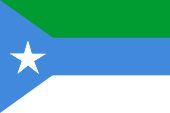 |
Jubaland seit/since: 28. Aug. 2013, Fläche/Area: 110.293 km² (42.584 sq.mi.) Einwohner/Population: 1.360.633 (2014) Hauptstadt/Capital: Kismayo Quelle/Source, nach bei: Wikipedia (EN) |
|
|
|
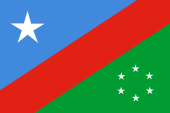 |
Koonfur Galbeed seit/since: 25. Jun. 2014 Fläche/Area: 98.863 km² (38.171 sq.mi.) Einwohner/Population: 4.387.355 (2022) Hauptstadt/Capital: Baidoa Quelle/Source, nach bei: Wikipedia (EN) |
|
|
|
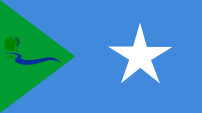 |
Hirshabelle seit/since: 05. Oct. 2016 Fläche/Area: ca. 80.000 km² (ca. 31.000 sq.mi.) Einwohner/Population: 3.771.638 (2020) Hauptstadt/Capital: Beledweyne Quelle/Source, nach bei: Wikipedia (EN) |
|
|
|
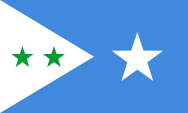 |
Galmudug seit/since: 14. Aug. 2012 Fläche/Area: 100.370 km² (38.750 sq.mi.) Einwohner/Population: 3.800.000 (2019) Hauptstadt/Capital: Dusmareb Quelle/Source, nach bei: Wikipedia (EN) |
Landkarte – Map: |
Lage – Position: |
Landkarte des Landes – Map of the Country: |
Das Horn von Afrika, 2012 – The Horn of Africa, 2012: Quelle/Source: Freeware, University of Texas Libraries, modyfied by: Volker Preuß |
Das Horn von Afrika, 2023 – The Horn of Africa, 2023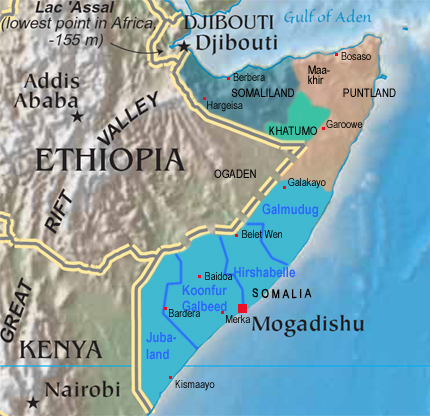 Quelle/Source: Freeware, University of Texas Libraries, modyfied by: Volker Preuß |
|
|
| Zahlen und Fakten – Numbers and Facts: | |
|
|
|
|
|
|
|
|
|
|
|
|
|
|
|
|
|
|
| Antike ·
Handel zwischen den Somali aus Punt und Ägypten, später auch mit dem
Römischen Reich 7. Jahrhundert · an der Küste erste Kontakte mit dem Islam 10. Jahrhundert · Gründung von Mogadischu, Barawa und Merka durch arabische und persische Händler, Herausbildung von Stadtstaaten 15. Jahrhundert · Islamisierung 16. Jahrhundert · Eroberung der Ostküste durch die Portugiesen 17. Jahrhundert · der Sultan von Maskat (Oman) erobert die Ostküste und vertreibt die Portugiesen 1856 · Tod des Sultans Seyyid Said von Oman, Teilung des Landes (Spaltung der Dynastie in zwei Linien) in das Sultanat Oman und das Sultanat Sansibar (mit den Inseln Sansibar, Pemba, Lamu, Manda, Patta einschließlich der gesamten afrikanischen Ostküste zwischen Kap Delgado und Mogadischu) 1885–1890 · das Deutsche Reich versucht über die Deutsch-Ostafrikanische Gesellschaft im Bereich der Somalischen Ostküste Kolonialbesitz zu erwerben, jedoch ergeben sich Konflikte mit Großbritannien und Italien Französisch-Somaliland: siehe Dschibuti Britisch-Somaliland: siehe Somaliland Italienisch-Somaliland: 1889 · Italien besetzt die Stadt Obbia an der Ostküste 1892–1893 · Italien pachtet die Besitzungen Sansibars an der Ostküste 1905 · Italien kauft die Besitzungen Sansibars an der Ostküste 1908 · Bildung der Kolonie Italienisch-Somaliland 1888, 1894, 1906 · Grenzverträge zwischen Italien, Großbritannien, Frankreich und Äthiopien, Aufteilung der von Somalis bewohnten Gebiete 1924 · Großbritannien tritt das Jubaland an Italien ab 1926 · Jubaland wird an Italienisch-Somaliland angegliedert 1941 · zweiter Weltkrieg, Britische Truppen besetzen das Land 1949 · Italienisch-Somaliland wird als Treuhandgebiet der UNO italienischer Verwaltung unterstellt 1943 · Gründung der "Liga der jungen Somali" (Somali Youth League, SYL), Forderung nach Unabhängigkeit und Vereinigung aller Somali-Länder 1956 · Wahlen, Sieg der SYL, Bildung einer Regierung, Italien gewährt Halbautonomie 01.07.1960 · Italien gewährt Unabhängigkeit, Vereinigung des ehemaligen Italienisch-Somaliland mit dem ehemaligen Britisch-Somaliland zur Republik Somalia, Präsident: Adan Abdullah Osman, Ministerpräsident: A. R. A. Shermake Somalia: 1964 · Krieg gegen Äthiopien um die von Somalis bewohnte Provinz Ogaden 21.10.1969 · Putsch durch General Siyad Mohammed Barre, Proklamation der Demokratischen Republik Somalia 1972 · Somali wird Amtssprache, Einführung der lateinischen Schrift 01.07.1976 · Einführung des Ein-Parteien-Systems unter der Somalischen Revolutionären Sozialistischen Partei (SRSP) 1977–1982 · Krieg gegen Äthiopien um die von Somalis bewohte Provinz Ogaden, die "Westsomalische Befreiungsfront" setzt im Ogaden den Kampf zum Anschluss der Provinz an Somalia fort 01.08.1979 · neue Verfassung 1980–1982 · Ausnahmezustand, Unruhen, Aufstände, Kämpfe 1988 · Bürgerkrieg zwischen der Barre-Regierung und der Somalischen Nationalbewegung (SNM, Somali National Movement) 1989 · alle oppositionellen Gruppen schließen sich gegen die Barre-Regierung zusammen 1991 · Sturz der Barre-Regierung, Siyad Mohammed Barre flieht nach Nigeria, das Anti-Barre-Bündnis zerbricht, Kämpfe zwischen den oppositionellen Gruppen, vor allem zwischen den Truppen von General Ali Mahdi Mohammed und General Aidid, Aidid besetzt Mogadischu 24.05.1991 · das ehemalige Britisch-Somaliland spaltet sich als Republik Somaliland von Somalia ab und erklärt seine Unabhängigkeit 21.07.1991 · Proklamation der Republik Somalia 1992 · US-Truppen marschieren im Auftrag der UNO in Somalia ein 1993 · das Somali Patriotic Movement (SPM) erobert Jubaland, das Gebiet westlich des Flusses Juba, internationale Truppen marschieren im Auftrag der UNO in Somalia ein 1995 · Niederlage der UN-Truppen gegen die Somali, Abzug der UNO und ihrer Truppen aus Somalia, Tod von General Siyad Mohammed Barre in Lagos (Nigeria), die Untergruppe der Dir des Clan der Issa proklamiert die Republik Awdal im äußersten Nordwesten nahe Dschibuti 1996 · Tod des Generals Aidid, Fortsetzung des Bürgerkriegs August 1996 · Waffenstillstand 1997 · Bildung einer Regierung unter Ali Mahdi Mohammed 1998 · das Somali Patriotic Movement (SPM) proklamiert den unabhängigen Staat Jubaland 1998–2000 · erneute Kämpfe zwischen verfeindeten Milizen in Süd-Somalia und Mogadischu 23.07.1998 · Abspaltung der "Autonomen Region Puntland" 1999 · die Juba Valley Alliance (JVA) erobert Jubaland und proklamiert den Staat Jubaland, loyal zur Zentralregierung in Mogadischu 2000 · Gründung einer Exilregierung unter Abdulkassim Salat Hassan in Arta (Dschibuti), Anerkennung durch die UNO 2002–2005 · der Rahanweyn-Clan proklamiert und betreibt den Staat Südwestsomalia in und um Baidoa 2004 · Wahl von Abdullahi Yusuf Ahmed zum Präsidenten in Mogadischu 2005 · Angriffe der von Eritrea unterstützten radikalislamischen "Union islamischer Gerichte", Flucht der Regierung Ahmed nach Baidoa Juni 2006 · die "Union islamischer Gerichte" erobert Mogadischu 14.08.2006 · der Staat Galmudug spaltet sich von Puntland ab September 2006 · die "Union islamischer Gerichte" erobert Kismayu und Baidoa, Athiopien sieht seine territoriale Integrität gefährdet und beginnt mit Luftangriffen November/Dezember 2006 · äthiopische Truppen und Truppen der somalischen Regierung gehen zum Angriff gegen die "Union islamischer Gerichte" über 26.12.2006 · äthiopische Truppen und Truppen der somalischen Regierung erobern Baidoa 28.12.2006 · die "Union islamischer Gerichte" flieht aus Mogadischu, Einzug der somalischen Regierung 31.12.2006 · die "Union islamischer Gerichte" flieht aus Kismayu und zieht sich in Richtung der Grenze zu Kenia zurück 2006–2010 · Ausweitung des Bürgerkriegs bis in die Hauptstadt Mogadischu hinein, Massenflucht, es bilden sich unzählige Somalische Staaten, einige erklären sich für unabhängig, andere Unterstellen sich der Zentralregierung, Entstehung der Al-Shabab-Miliz aus der islamistischen Gruppe "Union islamischer Gerichte" heraus 2009 · die äthiopischen Truppen verlassen das Land, militante Islamisten breiten sich im ganzen Land aus, Entstehung der islamistischen Gruppe "ASWJ - Al Sunna wal Jamma" 2010–2011 · Auseinandersetzungen zwischen den islamistischen Gruppierungen (Al-Shabab, Hizbul Islam), Al-Shabab zieht sich aus Mogadischu zurück, in Jubaland gründet sich der Staat Raskamboni 2011 · Truppen der Republik Kenia marschieren im Süden Somalias ein um al-Shabaab zu bekämpfen, mit Hilfe der Truppen der Afrikanischen Union aus Äthiopien und Kenia gelingt es der Zentralregierung wieder in Mogadischu Fuß zu fassen und ihre Macht zu stabilisieren, Gründung der Republik Azania in Jubaland 2012 · die Untergruppe der Abgal des Hawiye-Clans proklamiert im Süden der Provinz Galguduud den Staat Mareeg, erste Vorstellungen über die Schaffung eines föderalen Somalia 25.08.2012 · Proklamation der Bundesrepublik Somalia 2012–2016 · durch Verhandlungen gelingt es der Zentralregierung die vielen Somalischen Staaten und separatistischen Bewegungen regional in vier Bundesstaaten zu vereinen, Hauptproblem bleiben die islamistischen Milizen, die ca. ein Viertel des Landes kontrollieren |
| antiquity
· trade between the Somali from Punt and Egypt, later also with the Roman
Empire 7th century · first contacts with the Islam at the coast 10th century · foundation of Mogadishu, Barawa and Merka by Arabian and Persian merchants, evolution of town-states 15th century · islamization 16th century · conquer of the eastern coast by the Portugese 17th century · the Sultan of Mascat (Oman) conquers the eastern coast and banishes the Portugese 1856 · death of Sultan Seyyid Said of Oman, division of the country (split of the dynasty in two lines) in the Sultanate of Oman and the Sultanate of Zanzibar (with the islands of Zanzibar, Pemba, Lamu, Manda, Patta including the whole African eastern coast between Cape Delgado and Mogadishu) 1885–1890 · the German Empire attempts to acquire colonial property in the area of the Somali east coast through the German East African Society, but conflicts arise with United Kingdom and Italy French Somaliland: look: Djibouti British Somaliland: look: Somaliland Italian Somaliland: 1889 · Italy occupys the town Obbia at the eastern coast 1892–1893 · Italy leases the possessions of Zanzibar at the eastern coast 1905 · Italy purchases the possessions of Zanzibar at the eastern coast 1908 · formation of the colony of Italian Somaliland 1888, 1894, 1906 · frontier treaties between Italy, United Kingdom, France and Ethiopia, division of the by Somali inhabited territories 1924 · United Kingdom cedes Jubaland to Italy 1926 · Jubaland becomes affiliated to Italian Somaliland 1941 · Second World War, British troops occupy the country 1949 · Italian Somali under Italian administration as an UNO trust territory 1943 · establishment of the "Somali Youth Leagland becomes subordinatedue" (SYL), claims for independence and unification of all Somali countries 1956 · elections, victory of the SYL, formation of a government, Italy grants semi-autonomy 1st of July 1960 · Italy grants independence, unification of the former Italian Somaliland with the former British Somaliland to the Republic of Somalia, President: Adan Abdullah Osman, Premier: A. R. A. Shermake Somalia: 1964 · war against Ethiopia to gain the by Somali inhabited province of Ogaden 21.10.1969 · coup d’état of General Siyad Mohammed Barre, proclamation of the Democratic Republic of Somalia 1972 · Somali becomes official language, introduction of the Latin writing 1st of July 1976 · introduction of the single-party-system under the Somali Revolutionar Socialistic Party (SRSP) 1977–1982 · war against Ethiopia to gain the by Somali inhabited province of Ogaden, the "West Somali Liberation Front" continues the struggle in Ogaden for the annexion of the province by Somalia 1th of August 1979 · new constitution 1980–1982 · state of emergency, agitations, riots, struggles 1988 · civil war between the government of Barre and the Somali National Movement (SNM) 1989 · all opposing groups join against the government of Barre 1991 · overthrow of the government of Barre, Siyad Mohammed Barre flees to Nigeria, the anti-Barre-alliance breaks, struggles between the opposing groups, especially between the troops of General Ali Mahdi Mohammed and General Aidid, Aidid occupys Mogadishu 24th of May 1991 · the former British Somaliland separates as Republic of Somaliland from Somalia and declares its independence 21st of July 1991 · proclamation of the Republic of Somalia 1992 · US-troops invade Somalia on behalf of the UNO 1993 · the Somali Patriotic Movement (SPM) conquers Jubaland, the area west of the river Juba, international troops invade Somalia on behalf of the UNO 1995 · defeat of the UNO-troops against the Somali, withdrawal of the UNO and its troops from Somalia, death of General Siyad Mohammed Barre in Lagos (Nigeria), the Dir subgroup of the Issa clan proclaims the Republic of Awdal in the far northwest near Djibouti 1996 · death of General Aidid, continuation of the civil war August 1996 · cease fire 1997 · formation of a government under Ali Mahdi Mohammed 1998–2000 · once more struggles between enemy militias in Southern Somalia and Mogadishu 1998 · the Somali Patriotic Movement (SPM) proclaims the independent state of Jubaland 23rd of July 1998 · separation of the "Autonomous Region of Puntland" 1999 · the Juba Valley Alliance (JVA) conquers Jubaland and proclaims the state of Jubaland, loyal to the central government in Mogadishu 2000 · establishment of an exile government under Abdulkassim Salat Hassan in Arta (Djibouti), recognition by the UNO 2002–2005 · the Rahanweyn clan proclaims and runs the state of South-West Somalia in and around Baidoa 2004 · election of Abdullahi Yusuf Ahmed to president in Mogadishu 2005 · attacks of the by Eritrea supported radical-islamic "Union of Islamic Courts", escape of the government of Ahmed to Baidoa June 2006 · the "Union of Islamic Courts" conquers Mogadishu 14th of August 2006 · separation of the state of Galmudug from Puntland September 2006 · the "Union of Islamic Courts" conquers Kismayu and Baidoa, Ethiopia sees its territorial integrity endangered and starts air strikes November/December 2006 · Ethiopian troops and troops of the Somali government start the offensive against the "Union of Islamic Courts" 26th of December 2006 · Ethiopian troops and troops of the Somali government conquer Baidoa 28th of December 2006 · the "Union of Islamic Courts" flees from Mogadishu, marching in of the Somali government 31st of December 2006 · the "Union of Islamic Courts" flees from and withdraws in direction of the frontier to Kenya 2006-2010 · civil war spreads to the capital Mogadishu, mass exodus, countless Somali states are formed, some declare themselves independent, others submit to the central government, Al-Shabab militia emerges from the Islamist group "Union of Islamic Courts" 2009 · Ethiopian troops leave the country, militant Islamists spread throughout the country, emergence of the Islamist group "ASWJ - Al Sunna wal Jamma" 2010-2011 · clashes between the Islamist groups (Al-Shabab, Hizbul Islam), Al-Shabab withdraws from Mogadishu, the state of Raskamboni is founded in Jubaland 2011 · troops of the Republic of Kenya invade southern Somalia to fight al-Shabaab, with the help of African Union troops and from Ethiopia and Kenya, the central government manages to regain a foothold in Mogadishu and stabilise its power, founding of the Republic of Azania in Jubaland 2012 · the Abgal subgroup of the Hawiye clan proclaims the state of Mareeg in the south of Galguduud province, first ideas about the creation of a federal Somalia 25.08.2012 · Proclamation of the Federal Republic of Somalia 2012-2016 · the central government succeeds through negotiations in uniting the many Somali states and separatist movements regionally into four federal states, the main problem remains the Islamist militias, which control about a quarter of the country |
| Quelle/Source: Atlas zur Geschichte, Wikipedia (EN), World Statesmen |
| Der Name "Somalia" leitet sich von seinen Bewohnern ab. Diese nennen sich "Somali", was übersetzt angeblich "die Gastfreundlichen" heißt. In Somali bedeuten die Worte "soo mal" soviel wie "geh und melke", evtl. als Einladung zum Milchtrinken gemeint, was vielleicht die Erklärung für die unterstellte Gastfreundschaft liefert. Man kann sich gut vorstellen, wie ein fremder Reisender mit dem Schiff an der Küste landet, einen Einheimischen trifft, der in Richtung seiner Behausung zeigt und "soo mal" ruft, und der Gast des Geste als Benennung des Landes umdeutet. Andererseits bedeutet das Wort "somal" in den Kuschitischen Sprachen am Horn von Afrika, zu denen auch das Somalische zählt, "dunkel" oder "schwarz", was sich vielleicht auf die sehr dunkle Hautfarbe einiger Somalis bezieht. Auf Arabisch steht das Wort "zamla" für "Vieh". |
The name "Somalia" is derived from its inhabitants. They call themselves "Somali", which supposedly translates as "the hospitable". In Somali, the words "soo mal" mean something like "go and milk", possibly meant as an invitation to drink milk, which perhaps provides the explanation for the assumed hospitality. One can well imagine a foreign traveller landing by ship on the coast, meeting a local who points in the direction of his dwelling and calls out "soo mal", and the guest reinterpreting the gesture as naming the country.
On the other hand, in the Cushitic languages of the Horn of Africa, which include Somali, the word "somal" means "dark" or "black", perhaps referring to the very dark skin colour of some Somalis. In Arabic, the word "zamla" means "cattle". |
| Quelle/Source: Atlas der wahren Namen, Handbuch der geographischen Namen, Volker Preuß | |